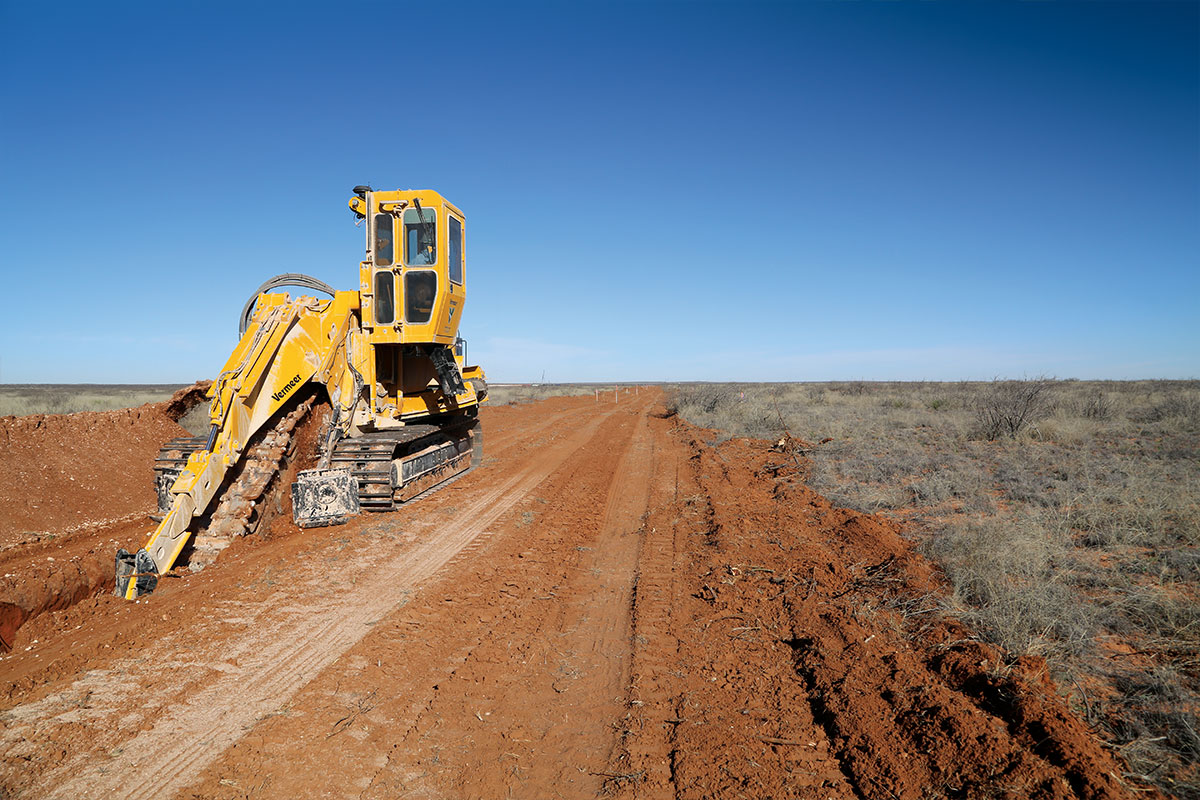If you want to maximise the metres of product placed in the ground while maintaining the longevity of your utility drills, it’s important to consider horizontal directional drilling (HDD) maintenance practices. Proactively addressing common component wear helps extend component life and prevent costly downtime.
Clint Recker, Vermeer Corporation product manager for utility HDD, recommends closely monitoring a variety of components on your rig, including:
- Sub saver
- Drill rods
- Grease buckets
- Rod wipers
- Vise dies
Read on for expert advice on caring for these wear parts.
SUB SAVER
The sub saver touches every drill rod and can quickly wear out if not properly maintained. Following recommended procedures for making and breaking rods and using the carriage float can help extend its life.
Being impatient when putting rod together and taking it apart can accelerate wear of the sub saver. This is where Vermeer drill rigs excel with their in-built torque limiter, able to stop the over-torquing of rod.
Good HDD maintenance includes keeping a close eye on the sub saver. Checking threads using thread gauges and replacing the sub saver in a timely manner can help prevent damage to the drill rod and other components.

Here’s how to determine when to replace the sub saver on your utility HDD rig.
- What to look for: Jagged edges or rounded thread profiles indicate that it’s time to swap out sub savers. But don’t just trust your eyes to determine the condition of threads. Use a thread profile gauge to accurately access the sub saver’s condition.
- What happens if you wait: The sub saver can potentially damage threads on every piece of drill rod it interacts with. You can damage a whole basket of rod due to a bad sub saver.
- Recker’s advice: “Be diligent when making and breaking rod. Use the carriage float; let it do its job. Gauges will help you evaluate wear on the sub and indicate when it should be replaced. Timely replacement of the sub saver will help extend the life of the drill rod.”
DRILL ROD
Drill rod will eventually need to be replaced. The threads wear over time and the rods can bend when over steered. Keeping drill rod threads clean, greased and covered when not in use will help maximise their life.
Vermeer sets the industry standard with the Vermeer Firestick. Constructed of forged and heat-treated, high-carbon alloy steel, Vermeer Firestick drill rod has earned a reputation in the industry for strength and consistent quality. From the robust threads to double-shouldered design, Firestick stands up in high-torque applications while maintaining a large inside diameter to maximise drilling fluid flow.
Each Firestick drill rod carries a batch number for traceability. Overall, it’s designed with a coarse and tapered thread profile for quick makeup and is made of V145 grade steel. Firestick rod is preferred for those that desire longer-term performance and are boring with a high degree of difficulty. It also provides operators a higher level of steerability while boring. This is the premium option for Vermeer drill rod and lets operators maximise their investment through longer wear and fatigue lifecycle on their drill rod.

GREASE BUCKET
When it comes to HDD maintenance, make sure every threaded connection is greased each time a rod is added. Visibly verify that there is grease in the bucket and that the auto greaser is performing properly.

- What to look for: Check the level of grease each day at startup and refill as needed.
- What happens if you wait: A lack of grease between threaded rod connections will accelerate wear and may result in seizing and galling. A lack of grease can also affect the friction between the threads and prevent the rod connections from achieving proper torque.
- Recker’s advice: “Rod grease prevents metal on metal threaded connections. So while this tip seems fairly obvious, it’s important to prevent accelerated rod wear.”
VISE DIES
The vise is responsible for torquing and un-torquing every drill rod going into the ground. Gripping each connection are vise dies, commonly referred to as vise jaws. Vice dies start off with small edges, or teeth, to grip the drill rod when making or breaking a connection. Over time, those edges will wear down and can start to slip when torquing a connection.

Here’s how to determine when to replace the vise dies.
- What to look for: You will see the slip marks on the drill rod instead of clearly identifiable teeth marks. If you notice rod slip, first try cleaning the vise dies. If the vise dies are still slipping, it may be time for replacements.
- What happens if you wait: Keeping the vise clean and replacing the dies when necessary can help prevent damage to the drill rod through improper torque. If the vise dies aren’t gripping, it’s hard to achieve the desired torque when making a rod. You work the machine harder when trying to break a connection. Properly torquing drill rod connections can result in fewer instances of the rod joints becoming overtightened downhole.
- Recker’s advice: “In addition to vise dies wearing out, grease buildup is another issue that operators should monitor. Grease in the vise dies prevents their teeth from grabbing and effectively holding the rod. Along with running a good rod wiper, it’s advised to power wash the vise die at least weekly. If the cleaned vise dies slip, swap them out.”
ROD WIPER
Every time a drill rod is pulled out of the ground it needs to be cleaned before putting it back in the rod box. That’s the function of the rod wiper. The rod wiper helps keep grit out of the vise dies and off the rack and rod loader arms. The rod wiper also helps prevent grit from entering the rod box.
Your crew should monitor the condition of the rod wiper.

- What to look for: Debris buildup on the vise dies and ribbons of mud on the drill rod are indications it may be time to replace the rod wiper.
- What happens if you wait: A worn wiper rod can allow contamination buildup on the vise dies and in the rod box.
- Recker’s advice: “You can help extend the life of a rod wiper by removing it when drilling out. The only time you need a rod wiper is when you’re returning rods to the box. You would then reinstall the rod wipers prior to pulling back.”
AN OUNCE OF PREVENTION
Time spent on the basic inspection and maintenance practices outlined above will pay dividends in the form of reduced downtime and extended life of these integral components. Considering the high-stakes nature of utility installation projects utilising HDD, it’s time well spent.
For more information about HDD maintenance or Vermeer’s drill line-up, contact your local Vermeer Australia team on 1300 VERMEER or visit vermeeraustralia.com.au.
Original piece by Vermeer Corporation.

 MyDealer:
MyDealer:


